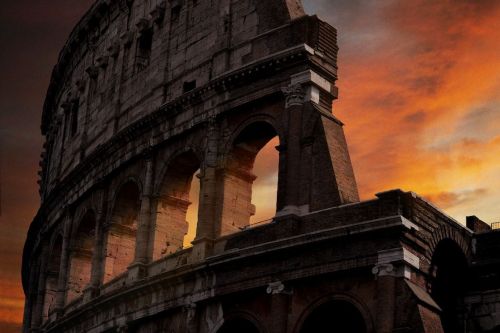Constantine I, also known as Constantine the Great, was a Roman emperor who reigned from 306 to 337 AD.
He was the author of numerous social, economic, and political reforms in the empire, which flourished during his reign. Constantine I was the first emperor to embrace Christianity, ending the persecution of Christians by his predecessor, Diocletian.
He issued the Edict of Milan, which proclaimed freedom of worship. He is a saint of the Eastern Orthodox Church.
He was the son of Flavius Constantius Chlorus, a Roman army officer who was one of the four emperors of the Tetrarchy. His mother, Helena, was a Greek of low social standing from Helenopolis. It is uncertain whether she was Constantius' legitimate wife or merely his concubine. In 288 or 289, Constantius left Helena to marry Emperor Maximian's stepdaughter, Theodora.
He studied Latin literature, philosophy, and Greek. He spent time in the culturally diverse environment of Nicomedia (the eastern, oldest capital of the Roman Empire, now a city in Turkey), where he met both pagan and Christian intellectuals. He may have attended the lectures of Lactantius, a Christian Latin scholar. Diocletian did not fully trust Constantine, who was treated as a hostage at his court. This made Constantine obedient to Diocletian.
He fought on the side of Diocletian and Galerius in Asia and served on various tribunates; he campaigned against the barbarians on the Danube in 296 and fought against the Persians under Diocletian in Syria in 297, as well as under Galerius in Mesopotamia.
At the end of 305 he became a tribune of the first class - tribunus ordinis primi.
Diocletian ordered the destruction of the new church in Nicomedia, the destruction of its writings and the confiscation of its goods. In the months that followed, other churches were destroyed and priests imprisoned.
It is unlikely that Constantine played any role in this persecution. In his later writings, he tried to portray himself as an opponent of Diocletian's "bloody edicts" against "God's followers." However, there is no indication that he successfully opposed them.
After the death of Constantius Chlorus in 306, his legions proclaimed Constantine I Augustus. Constantine immediately informed Galerius, who appointed him ruler of Gaul, Britain, and Spain, but gave him only the title of Caesar, not Augustus.
Five years later Constantine became the sole ruler of the West (there were two emperors in total at that time).
It removed penalties for professing Christianity and resulted in the return of confiscated church property. The edict protected all religions, not just Christianity, from persecution by allowing anyone to worship any deity. By decree of March 7, 321, Emperor Constantine I the Great established Sunday as the official holiday of Sol Invictus - dies Solis.
After his victory in the civil wars against the emperors Maxentius and Licinius, he became the sole ruler of the Roman Empire.
The inauguration ceremony of the new capital city took place in the year 330. The city later became the capital of the empire for more than a thousand years. The later Eastern Roman Empire was called the Byzantine Empire by modern historians.
Constantine I enacted many reforms to strengthen the empire. He restructured the government, separating civil and military authorities.
The new army consisted of mobile units (comitatenses) and garrison troops (limitanei) capable of repelling internal threats and barbarian incursions.
A few days before his death, Constantine I was baptized by the Arian bishop Eusebius of Nicomedia, although he had planned to be baptized in the waters of the Jordan River like Jesus.
Control of the funeral ceremonies was taken over by Constantine's son, Constantius, who arrived from Antioch. He ordered that his late father's coffin be moved to the recently completed mausoleum, where the funeral ceremony was continued by Christian clergy. Nevertheless, the funeral ceremony was not strictly Christian; it was mixed in character, with visible pagan influences found in the funerals of earlier Roman emperors.
There were other contenders for the succession, but they were slaughtered. With the remaining contenders gone, the army swore allegiance to Constantine's sons, who in September 337, at a meeting in Pannonia, divided the empire among themselves and assumed the titles of Augustus.
He built the Arc de Triomphe in 315 to celebrate his victory at the Battle of Mulvian Bridge, which was decorated with images of the goddess Victoria, and at its dedication offerings were made to pagan gods, including Apollo, Diana and Hercules.
There are no Christian symbols on the arch, as it was commissioned by the Senate.
This assembly was recognized as the first universal council at the Council of Ephesus in 431. Its decisions had a tremendous impact on the development of European religion, culture, and science, as well as influencing political events.
It was attended by some 250 bishops representing various theological and philosophical positions. The participants deliberated in the presence of the emperor, who participated in the discussions and supported compromise proposals.
The Council of Nicaea established a single date for the entire Roman Empire to celebrate the feast of Christ's resurrection, the first Sunday after the first full moon of spring.
Jews were forbidden to persecute other Jews who converted to Christianity. They were forbidden to own Christian slaves or to circumcise them. Jewish clergy were given the same privileges (exemptions from certain taxes) as Christian clergy.


